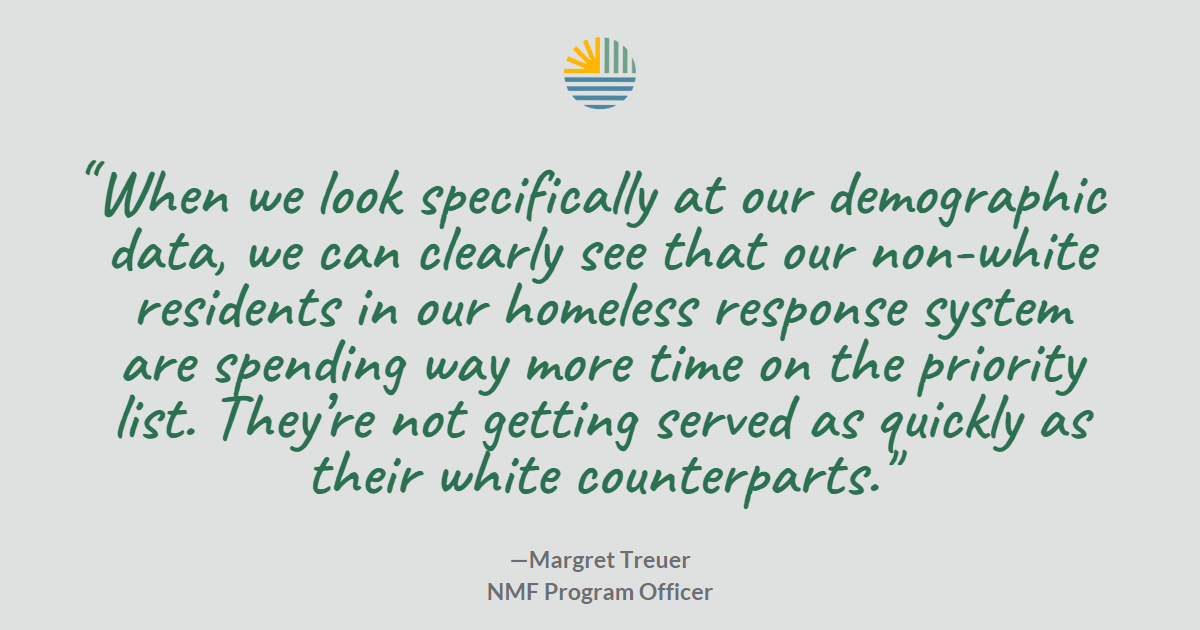COMMITMENT TO INCLUSION
‘Why do we let this happen?’
The Northwest Minnesota Racial Equity Accountability Project team is charged with examining and questioning the homeless response system with the goal of advancing racial equity and reducing racial disparities.

In the past, Sally Fineday resisted suggestions to view homeless camps in the area, to explore whether there were ways she could assist those who didn’t have permanent residences.
“The moment that I see it, I knew I’d try to help,” she reflected. “I just wasn’t ready to do that. I couldn’t. It just wasn’t in me at that time. That’s why I didn’t get involved until now.”
Until now.
Sally is a member of the Northwest Minnesota REAP team, a committee of community members who are examining and questioning the homeless response system with the goal of advancing racial equity and reducing racial disparities.
“When we look specifically at our demographic data, we can clearly see that our non-white residents in our homeless response system are spending way more time on the priority list. They’re not getting served as quickly as their white counterparts.”
This statement, from Margret Treuer, a program officer in Northwest Minnesota Foundation’s Homelessness program, encapsulates the purpose of REAP, the Racial Equity Accountability Project.
Composed of residents throughout Northwest Minnesota, the regional REAP committee meets monthly to review, discuss, and dissect data from the homeless response system. That data shows that, in Minnesota, people of color experience homelessness and housing instability at rates that are 7 to 8 times higher than their representation within the general population.
For Sally, not only are the disparities unacceptable but the idea that anyone experiences homelessness is just as unacceptable.
“It’s a pet peeve of mine, you know, that there are homeless people,” she said. “Why does that exist? Why do we let this happen? How?”

Earlier this year, someone passed Sally information on REAP and encouraged her to apply.
“That’s just the type of person I am – if I get involved in something that really disturbs me, I’m going to try to fix it,” Sally said.
Particularly frustrating, she said, was learning about the lack of supports for those experiencing homelessness. They might find shelter for the overnight but would then have to pack their things to vacate that space during the day, only to return again each evening.
“What disturbed me immensely was that children – whole entire families – were being kicked out in the morning, in the middle of winter time. What kind of people are we that we do that?” she wondered.
Instead, if the community was truly going to cultivate a continuum of care approach, she said, it would develop a system that offered not only for overnight shelter but also food, work, connectivity, and service opportunities – all at the same location.
“It would be a place where people can come and eat breakfast, maybe you could work at the elders place, bring your children and they could play with the elders – just do something that is meaningful to the people there,” she said.
Sally hopes that at least one outcome of her REAP work will help facilitate housing stability for those who are trying to emerge from homelessness.
“I hope that we have a new policy that requires certain housing standards,” she said. “If you’re going to take the money of a person with Section 8 housing (assistance), you have to have them for at least two years, that’s what I’m hoping will happen.”
The work of the REAP team is not focused solely on Northwest Minnesota. The regional REAP team meets virtually every other month with statewide facilitators and other regional REAP teams with the goal of advancing racial equity and reducing racial disparities throughout Minnesota’s homeless response system.
While the state intends to conclude its REAP work by January 2023, Margret said the Northwest Minnesota Foundation (NMF) and Northwest Minnesota Continuum of Care (NWCoC) is committed to REAP long-term.
“Our plan would be to continue REAP for as long as it takes – and even beyond that – so that we have something like a standing subcommittee of the NWCoC board that would be our racial equity committee that is constantly looking at how we can continuously make improvements in our system,” she said.
In the Northwest Minnesota region, about 72 percent of the people on the priority list for more than 90 days are Indigenous youth; 90 days is generally considered the benchmark for when people are staying too long on the list and not being served.
“We definitely see significant disparities when we look at how we are doing in terms of keeping homelessness rare, brief, and non-recurring,” Margret said.
For Sally, the statistics are both disturbing – and unsurprising.
“Being Indian in this country has really been hard,” she said. “We were the last people to even get citizenship here and we were the first people of this land.”





